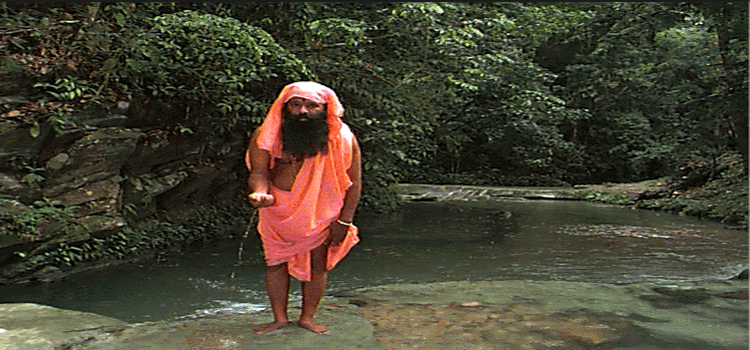108 beads of the rosary, 108 chants of the name of God. 54, 27, multiples of 108 each numbering 9 – sacred numbers. 108 steps to descend.
They vary in size and heights, perhaps deliberate, perhaps open to interpretation. These are the steps of life in a sense. Whether highs or lows, plateaus or valleys, chant the name of God on each and we are bound for salvation.
It seems that way anyway as we stand under the arch with the name Aripo Datta Ganga done in wrought iron. The surroundings are pristine. It is quiet, beautiful. The natural surroundings come closer and closer as you begin the descent, until you are at the bottom of the steps looking into a hermitage.
To the left some birds catch your attention. Silver-beaked and red-winged, their colours glitter like precious gemstones in the sunlight. On another, there are hummingbirds. Buildings flank the left and right of the compound. There is an open shed directly in front of the visitor, offering shade from the hot sun. As we walk past the shed, a small temple greets us, and a huge tree, the Audumbara.
It is said that anyone who makes an offering at the tree and circumambulates it have wishes fulfilled Sacred threads adorn the trunk, wishes already made and left in the hands of the gods.
The Aripo river, once the space of the First People also now holds a place in the Trinidad Hindu ideology. While all people involve themselves in place making, in Hinduism, there is a natural tendency to map the sacred landscape.
As Diana Eck, a religion scholar writes in India: A Sacred Geography, ‘the entire land of India is a great network of pilgrimage places — referential, inter-referential, ancient and modern, complex and ever-changing… nothing…stands alone, but rather everything is part of a living, storied and intricately connected landscape’.
The story of the Aripo River, now a popular Hindu pilgrimage site, is one such example of the interconnectivity of human beings and ideas.
Founder of the Dattatreya Temple — now famed for its 85ft Hanuman mūrti — Sri Ganapathy Sachchidananda Swamiji explained in an interview in 2010, that since his youth he had been introduced to the Brahmanda Purana by his father.
This text spoke of a holy river in India as well as one particular river in the western hemisphere named the Sararipu Nadi/ river whose water had great powers of physical and spiritual healing. A few years later, Sri Swamiji set off to the West in search of this holy river. The journeys covered eleven years and took him to North America and Europe, where he took a bath in several rivers.
When finally His Holiness visited Trinidad for the first time on the 12th August, 1976 one of the first things he did the very next morning was to proceed east of Arima, and upon reaching the Aripo Road, embarked upon that route. Shortly thereafter, he arrived at the river and proceeded to announce that this was indeed the Holy Sararipu River. The search was over.
In the sacred Bramhanda Purana, the Saptarishi Nadi was described as the confluence of five rivers. It was described by the poet Kalidas in the Puranas. Here seven great Rishis came to take bath, meditate and do penance. This site was the abode of the ancient Rishis.
Sri Swamiji would later explain that over 25,000 years ago this river carried the name Sararipu Nadi and was connected with the holy Ganges at the time when the Earth was one geographical land mass although our scriptures cite so many rivers. This was the chosen one in the West.
In the early stages of development of life on Earth, lower life forms like insects and monkeys evolved, followed by humans (Aarya). The Holy Sararipu River came side by side with the Aarya development. There is an intrinsic link between the river and our dharma.
Sri Swamiji says. ‘Without the river there is no dharma, without the river there is no human body.’ Sri Swamiji indicated that although the Aripo River is small, it consists of five lines or pancha nadi. This river originates from the highest point in Trinidad, from the summit of the Cerro del Aripo mountain peak at 3,084 feet (940 metres) elevation. The flowing water is highly medicated because of its passage through the forest and mineral rocks. Its water is of a different colour and its taste unique, having high medicinal value.’ Today the Aripo river is the site of Ganga Dushara festival and Kartik Snaan, as well as a place where devotees go throughout the year to experience the healing and spiritual powers of the water.
Many devotees attest to the healing that they have experienced through these baths. Some of these testimonials now come together in the form of a book Glory of the Aripo Datta Ganga which was released by Sri Swamiji on July 28 while on his 27th visit to Trinidad and Tobago.
One chapter by Swami Brahmadeva, deals with the significance of the Ganges river while others are contributions by devotees about their experience of the Aripo river. A noteworthy one is the river’s importance to the formation of the Nada Sangama Steel Orchestra.




